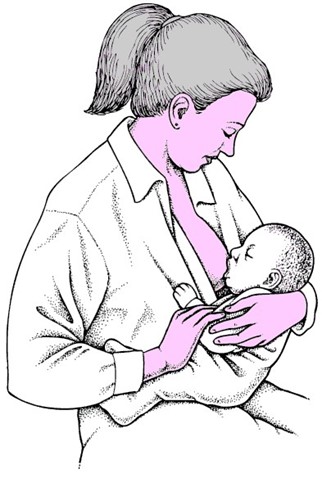A nurse is caring for a newborn immediately following birth and notes a large amount of mucus in the newborn's mouth and nose. Identify the sequence the nurse should follow when performing suction with a bulb syringe.
Assess the newborn for reflex bradycardia.
Compress the bulb syringe.
Use the bulb syringe to suction the newborn's nose.
Place the bulb syringe in the newborn's mouth.
The Correct Answer is B,D,C,A
The correct answer is choice B, D, C, A. B. Compress the bulb syringe: The nurse should first compress the bulb syringe to expel air from it. This ensures that when it is placed in the newborn’s mouth or nose, it can create suction to effectively remove mucus. D. Place the bulb syringe in the newborn's mouth: The nurse should then place the compressed bulb syringe into the newborn’s mouth first, as clearing the mouth is essential before the nose to prevent aspiration. C. Use the bulb syringe to suction the newborn's nose: After suctioning the mouth, the nurse should use the bulb syringe to suction the nose. Suctioning the nose after the mouth helps to clear the airway more effectively and reduce the risk of mucus being aspirated into the lungs. A. Assess the newborn for reflex bradycardia: After suctioning, the nurse should assess the newborn for any signs of reflex bradycardia, which can occur due to vagal stimulation during suctioning. This ensures the newborn's heart rate and overall well-being are monitored.
Nursing Test Bank
Naxlex Comprehensive Predictor Exams
Related Questions
Correct Answer is D
Explanation
This suggests that the nurse should assess the newborn's latch while breastfeeding. Sore nipples are a common concern among breastfeeding mothers, and the most common cause is an improper latch. The nurse should ensure that the baby is latching on correctly and not causing trauma to the mother's nipples. A proper latch involves the baby taking in a good portion of the areola and not just the nipple. Assessing the newborn's latch can help identify any issues with the baby's mouth or tongue that may be causing difficulty latching on. If the baby is not latching correctly, the nurse can provide education and support to help the mother correct the issue. Offering supplemental formula between feedings (choice A) is not recommended as it can decrease the frequency of breastfeeding and reduce the stimulation for milk production, leading to decreased milk supply. Instructing the client to wait 4 hours between daytime feedings (choice C) is not recommended as it can decrease milk production and lead to inadequate nutrition for the newborn.
suggests that the nurse should assess the newborn's latch while breastfeeding. Sore nipples are a common concern among breastfeeding mothers, and the most common cause is an improper latch. The nurse should ensure that the baby is latching on correctly and not causing trauma to the mother's nipples. A proper latch involves the baby taking in a good portion of the areola and not just the nipple. Assessing the newborn's latch can help identify any issues with the baby's mouth or tongue that may be causing difficulty latching on. If the baby is not latching correctly, the nurse can provide education and support to help the mother correct the issue. Offering supplemental formula between feedings (choice A) is not recommended as it can decrease the frequency of breastfeeding and reduce the stimulation for milk production, leading to decreased milk supply. Instructing the client to wait 4 hours between daytime feedings (choice C) is not recommended as it can decrease milk production and lead to inadequate nutrition for the newborn.
Correct Answer is C
Explanation
The client tested positive for group B streptococcus, which is a bacterial infection commonly found in the genital tract of women. Ampicillin is an antibiotic that is used to treat this type of infection. It is given intravenously to the client during labor to prevent the transmission of the infection to the newborn.
Whether you are a student looking to ace your exams or a practicing nurse seeking to enhance your expertise , our nursing education contents will empower you with the confidence and competence to make a difference in the lives of patients and become a respected leader in the healthcare field.
Visit Naxlex, invest in your future and unlock endless possibilities with our unparalleled nursing education contents today
Report Wrong Answer on the Current Question
Do you disagree with the answer? If yes, what is your expected answer? Explain.
Kindly be descriptive with the issue you are facing.
